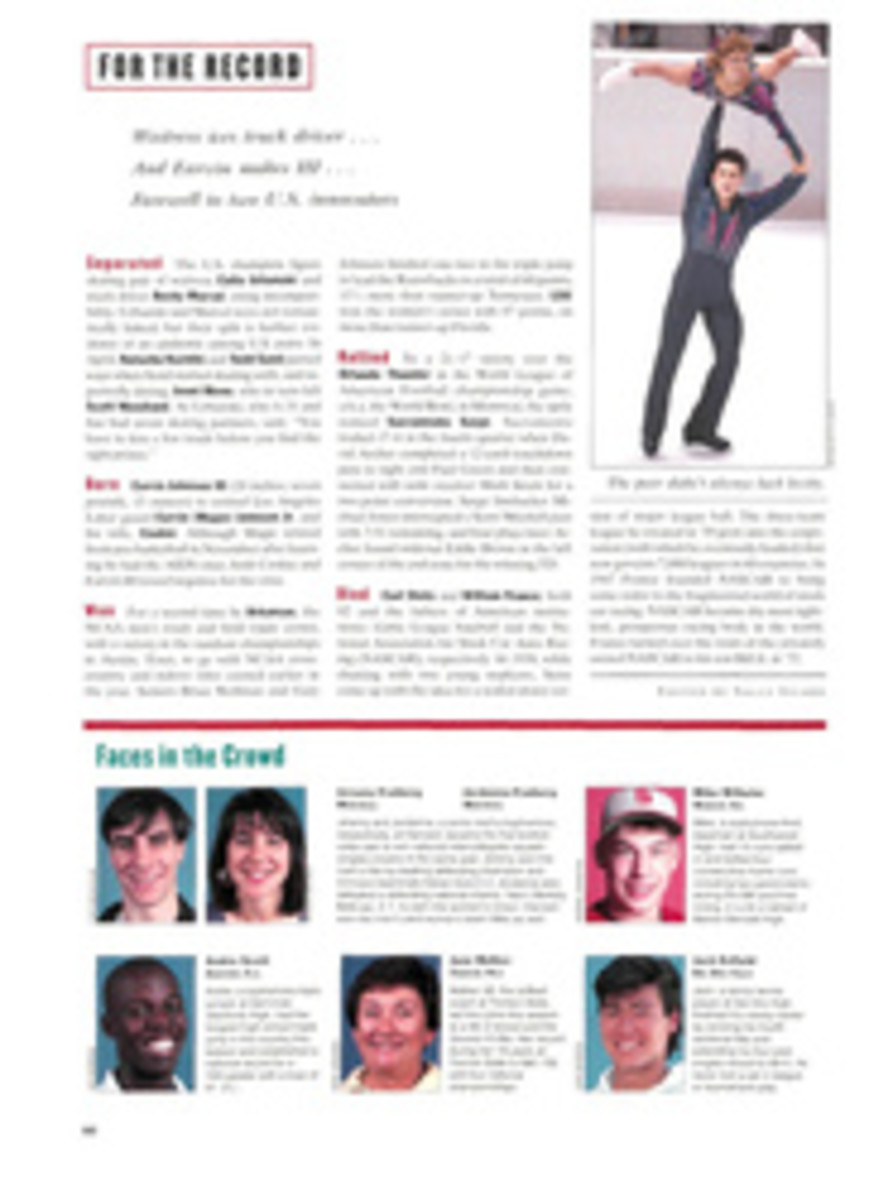
Getting the Drop on Some Moose
Ah, summer in the Arctic.
The ice is thawing, the sun is out—for nearly 24 hours—and in Talkeetna (pop. 400), Alaska, it is the cherished season when Grete Perkins heads for her woods to collect moose droppings for the popular Talkeetna Moose Dropping Festival, which will celebrate its 20th anniversary July 10-12.
"You have to go with your strength," says Gene Jenne, 62, owner of a fuel company and a longtime resident of Talkeetna, who barely flinches when introduced to a visitor as the town curmudgeon, "and come the springtime you can describe our ground cover in just two words: moose droppings. Millions of them. We are extraordinarily blessed, I guess you could say."
As you might expect, the centerpiece of the festival is the dropping toss. Essentially, you aim your dropping at a target, and points are awarded for accuracy. You get 10 droppings for a buck; a whole bucket for $30 or so.
"The prizes aren't so special," says Perkins, 50, curator at the Talkeetna Historical Society museum and an organizer of the event, "but it's the honor of tossing moose droppings that counts mostly." All proceeds from the festival go to the historical society.
A moose dropping is about the size of a Milk Dud, but it is lightweight, like a piece of pumice or a Styrofoam chip, and very unpredictable aerodynamically.
"I spray the droppings with a fixative," Perkins says, taking from her desk a souvenir box with some sample nuggets. "Otherwise they deteriorate. But once the droppings are dried out, people use them to make necklaces, earrings, tie tacks, brooches."
Any market for this?
"Oh, why yes," she says. "Last year our big item was moose-dropping swizzle sticks, although you've got to be careful not to let the dropping get in your drink."
"One year," recalls Jenne, "the wife dipped them in chocolate and rolled them in coconut, and we put them out in a bowl on the coffee table." He chuckles. "Fellow came this close to eating one." Dropping-shaped chocolates are on sale in Talkeetna for the Alaskan practical joker in all of us.
"We're thinking of copyrighting the game," Perkins says of the festival's main event. "A big moose-shaped target, highest points for landing a nugget right on the antlers. Of course, Talkeetna would have the monopoly on supplying the droppings."
The eccentric community of Talkeetna lies near the foot of Mount McKinley, which at 20,320 feet is North America's highest peak, and the village ordinarily does a lucrative business in serving climbers and backpackers who are heading upward. Busy D Street is used as a landing strip by bush pilots; the Fairview Inn on the corner has a wind sock on the roof. Newcomers to town scramble and hit the ground as pilots line up and bring in their planes a mere 50 or 60 feet above the rooftops.
The village was named by the Tanaina native people; talkeetna means "river of plenty." In 1896 that proved prophetic when gold was found in tributaries of the nearby Susitna River. When the gold played out around 1920, the town became a riverboat stop, and then a few years later the railroad came through. It was only in 1964 that the village was connected to the rest of Alaska by the road from Anchorage to Fairbanks. This feisty town, which never says die, is putting itself on the map again with the Moose Dropping Festival; some 3,000 visitors made the trek in 1991 for the weekend-long festival of food, music, moose scatophilia and assorted unusual contests.
Such as the Mountain Mother Contest. This is the summertime answer to the Talkeetna Bachelor Society annual Wilderness Woman Competition held each winter for single and eligible women. In the snows of December the bachelorette is expected, among other things, to run a snowmobile through an obstacle course and—most important for those hoping for matrimonial consideration—make a sandwich and deliver it to a bachelor lounging in front of a television.
"We figured that mothers needed a chance to prove their skills as well," says Perkins, "so for the festival we devised an event. The only qualification was that you had to be a mother. Women come up all the way from Anchorage to compete."
Last year, Susan Dolecki, 37, a mother of three from Talkeetna, took top honors and received flowers, a bottle of champagne and a picnic basket filled with gourmet items.
The event is staged on a local ball field. Wearing waders and carrying a baby doll like a papoose on her back, the Mountain Mother must "cross the Susitna" on stepping-stones while holding two bags of groceries. Once on the "other side," she must walk a 20-foot beam, put down the groceries to chop three rounds of wood, carry the splits to the woodpile, blow up a balloon and affix it to an archery target and hit the bull's-eye 60 feet away (she gets 12 arrows). Then she must cast a fishing line 100 feet and reel it back in, change the doll's diaper, wash the diaper and hang it on a clothesline, open a can of cherries and prepare a pie and, finally, ring the dinner bell. Dolecki's time was four minutes, 57 seconds.
Events like these have spread the Talkeetna Moose Dropping Festival's fame throughout Alaska and to points beyond. "We got a call," says Jenne, with a look of distaste, "from an animal-rights organization in Florida. They threatened to come up here and protest the Moose Dropping Festival. They wanted to know from what height we were dropping the moose. I told them 3,000 feet from a helicopter, and we can hardly wait for them to drive 7,000 miles up here and give us a lecture. Have you ever heard anything so crazy?"
Well, craziness is a relative concept come summertime above the 60th parallel. In Skagway the locals will be celebrating the memory of Soapy Smith (July 8), con man, gunfighter, outlaw and self-proclaimed mayor, with champagne provided by his remaining relatives. In Nome, after enough ice melts later this month, some hearty residents will take a dip in the 35° Bering Sea for the Great Polar Bear Swim. On June 21, 100 people will enter homemade rafts complete with TV sets and lawn chairs in the Nome River Raft Race in hopes of winning its famous trophy, a fur-lined honey bucket. And don't forget the Great Nome Bathtub Race down Front Street, which will take place on Sept. 7.
All of these events can best be explained in two words: cabin fever.
ILLUSTRATION
MICHAEL BARTALOS
Wilton Barnhardt's second novel, "Gospel," will be published next spring by St. Martin's Press.

